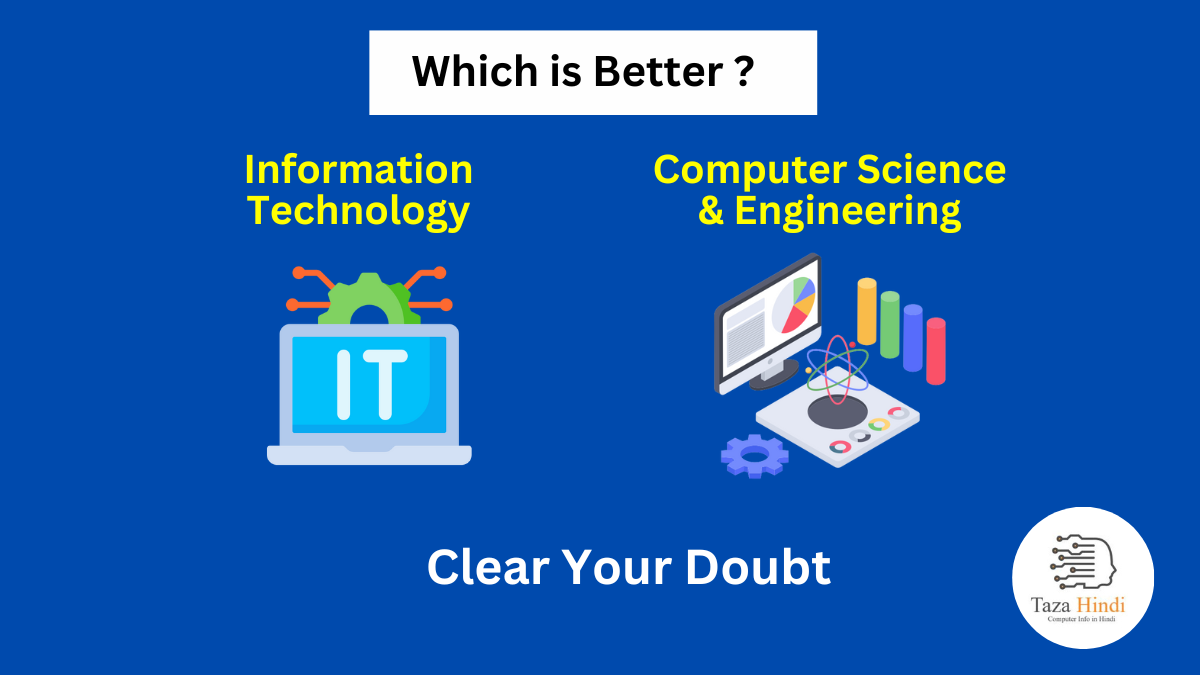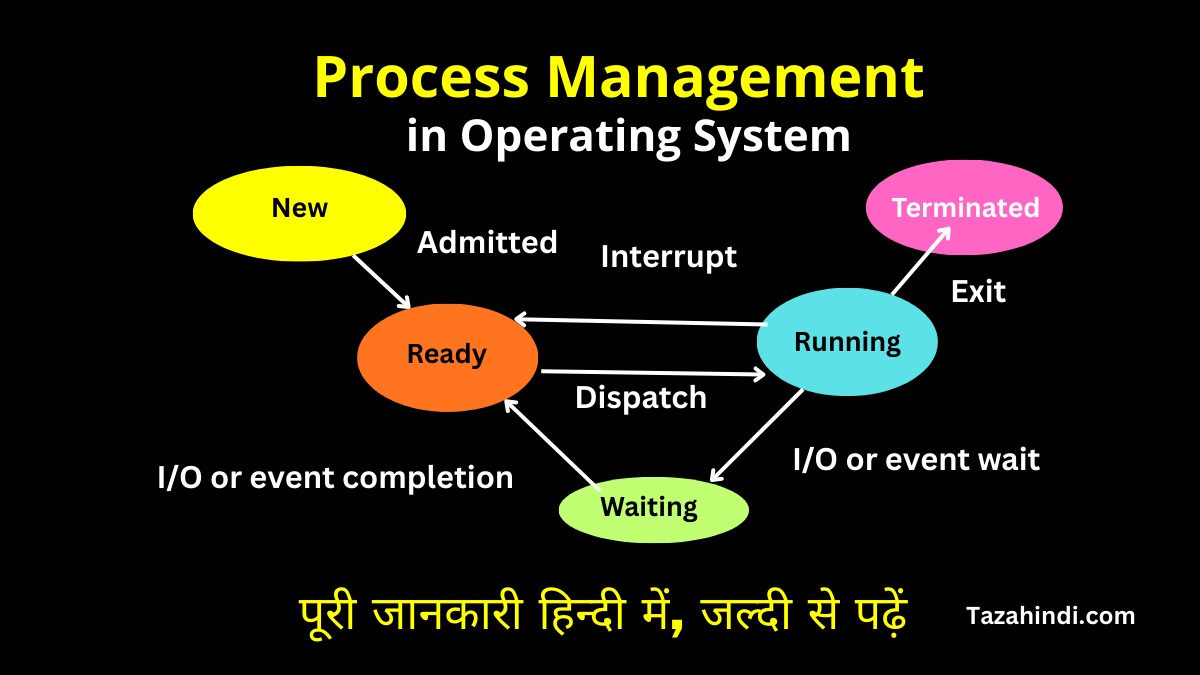In today’s technology-driven world, two prominent fields that often come up in discussions are Information Technology (IT) and Computer Science and Engineering (CSE). While they may seem similar on the surface, it’s important to understand their differences to make informed decisions about career paths and educational choices. In this article, I will explain definitions of IT and CSE, roles of professionals, academic programs, the unique skills, what knowledge may gained through these fields and then explore what are the difference between IT and CSE.
What is Information Technology (IT)?
Information Technology, commonly known as IT, refers to the utilization, management, and application of technology in various aspects of businesses and organizations. IT encompasses the use of computer systems, software, networks, and electronic infrastructure to store, process, transmit, and retrieve information.
Common subjects and courses in IT curricula
Information Technology (IT) curricula typically cover a range of subjects and courses that provide students with a solid foundation in technology concepts, skills, and practical applications. Here are some common subjects and courses found in IT curricula:
- Programming Fundamentals:
- Introduction to programming languages such as Java, C, C++, C#, PHP, .NET, Python, or JavaScript.
- Concepts of algorithm design, control structures, data types, and functions.
- Problem-solving techniques and logic development.
- Database Management:
- Introduction to relational database concepts.
- Structured Query Language (SQL) for database design, querying, and management.
- Database normalization, indexing, and optimization.
- Introduction to non-relational databases and data modeling.
- Computer Organization and Architecture:
- Digital logic circuits and boolean algebra.
- CPU design, memory systems, and input/output devices.
- Instruction set architecture and assembly language programming.
- Performance evaluation and optimization techniques.
- Computer Networking:
- Introduction to computer networks and network protocols.
- Network architectures, including LANs, WANs, and wireless networks.
- TCP/IP fundamentals, subnetting, and IP addressing.
- Network security, routing, and troubleshooting.
- Web Development:
- HTML, CSS, and JavaScript for web page design and interactivity.
- Client-side and server-side web development frameworks and libraries.
- Web application development using frameworks like React, Angular, or Node.js.
- Web security and performance optimization.
- Systems Administration:
- Introduction to operating systems (e.g., Windows, Linux, or macOS).
- Installation, configuration, and maintenance of operating systems.
- User management, file systems, and permissions.
- System monitoring, troubleshooting, and performance optimization.
- Cyber Security:
- Fundamentals of information security principles and concepts.
- Network security measures and technologies.
- Security policies, risk assessment, and incident response.
- Ethical hacking and penetration testing.
- Cryptography and secure communication protocols.
- Software Engineering:
- Software development methodologies (e.g., Agile or Waterfall).
- Requirements gathering, software design, and modeling.
- Software testing, quality assurance, and debugging.
- Version control systems and collaboration tools.
- Software project management and documentation.
- Data Analytics and Business Intelligence:
- Introduction to data analytics and visualization techniques.
- Data manipulation and analysis using tools like Excel or SQL.
- Business intelligence concepts and tools.
- Data mining, data warehousing, and data-driven decision-making.
- Project Management:
- Principles of project management and project lifecycle.
- Project planning, scheduling, and resource management.
- Risk assessment and management.
- Communication and stakeholder management.
- Agile project management methodologies.
Also Read : Top 10 Best Books for Computer Science Students
Role of IT professionals
IT professionals are responsible for implementing and maintaining technology solutions that address business needs. They ensure the smooth operation of computer systems, troubleshoot technical issues, and support end-users.
Examples of IT job roles and responsibilities
IT (Information Technology) encompasses various job roles, each with its own set of responsibilities. Here are some examples of IT job roles along with their associated responsibilities:
- Network Administrator:
- Installing, configuring, and maintaining computer networks.
- Managing network hardware, such as routers, switches, and firewalls.
- Monitoring network performance and troubleshooting network issues.
- Implementing network security measures, including firewalls and intrusion detection systems.
- Planning and implementing network upgrades and expansions.
- Systems Analyst:
- Assessing and analyzing business requirements for IT systems.
- Designing and documenting system specifications and workflows.
- Collaborating with stakeholders to gather system requirements and propose solutions.
- Evaluating existing systems and recommending enhancements or new technologies.
- Testing and implementing system changes and ensuring user training and support.
- IT Project Manager:
- Leading and managing IT projects from initiation to completion.
- Defining project goals, scope, and deliverables.
- Creating project plans, schedules, and budgets.
- Coordinating project resources and ensuring timely project execution.
- Monitoring project progress, identifying risks, and implementing mitigation strategies.
- Cyber Security Specialist:
- Protecting computer systems and networks from security threats and vulnerabilities.
- Conducting risk assessments and developing security policies and procedures.
- Implementing and managing security controls, including access controls and encryption.
- Monitoring and investigating security incidents and responding to breaches.
- Conducting security awareness training for employees and promoting security best practices.
- IT Consultant:
- Providing expert advice and guidance to clients on IT solutions and strategies.
- Assessing client needs and recommending appropriate technologies.
- Designing and implementing IT infrastructure and systems.
- Conducting technology audits and identifying areas for improvement.
- Supporting clients in technology selection, implementation, and troubleshooting.
- Database Administrator:
- Designing and managing databases to store and organize data efficiently.
- Installing and configuring database management systems.
- Ensuring data security, integrity, and availability.
- Monitoring database performance and optimizing query execution.
- Performing database backups, restoration, and recovery procedures.
- Help Desk Support Specialist:
- Providing technical support and assistance to end-users.
- Troubleshooting hardware and software issues.
- Resolving user problems through phone, email, or in-person communication.
- Logging and tracking support requests in a ticketing system.
- Assisting with user training and creating user documentation.
Also Read : Top 10 Certifications in Computer Science for High Salary in 2023
What Skills and knowledge can gained through IT education?
IT education offers a diverse set of skills and knowledge. Students acquire technical competencies such as programming, system administration, and database management. They also develop problem-solving, critical thinking, and analytical skills, enabling them to address complex technological challenges. Additionally, IT education emphasizes effective communication, teamwork, and project management, essential for collaborating with stakeholders and successfully implementing technology solutions.
What is Computer Science and Engineering (CSE)?
Computer Science and Engineering (CSE) is a field that encompasses the study of computer science principles, engineering concepts, and the development of hardware and software systems. CSE professionals are involved in designing, developing, and implementing computer-based solutions to address a wide range of challenges and meet societal needs.
Common subjects and courses in CSE curricula
Computer Science and Engineering (CSE) curricula are designed to provide students with a comprehensive understanding of computer science principles, engineering concepts, and practical skills. Here are some common subjects and courses found in CSE curricula:
- Programming and Data Structures:
- Introduction to programming languages such as Java, C++, or Python.
- Data types, control structures, functions, and object-oriented programming.
- Algorithms and data structures such as arrays, linked lists, stacks, queues, and trees.
- Algorithm analysis and efficiency.
- Computer Organization and Architecture:
- Digital logic circuits and boolean algebra.
- CPU design, memory systems, and input/output devices.
- Instruction set architecture and assembly language programming.
- Performance evaluation and optimization techniques.
- Operating Systems:
- Operating system concepts, processes, and threads.
- Process scheduling and synchronization.
- Memory management and virtual memory.
- File systems and storage management.
- Device management and input/output systems.
- Database Management Systems:
- Relational database concepts and design.
- SQL for database querying and manipulation.
- Database normalization, indexing, and optimization.
- Transaction management and concurrency control.
- Introduction to non-relational databases.
- Algorithms and Complexity:
- Design and analysis of algorithms.
- Sorting and searching algorithms.
- Graph algorithms and optimization problems.
- Dynamic programming and divide-and-conquer strategies.
- Complexity theory and NP-completeness.
- Software Engineering:
- Software development methodologies (e.g., Agile, Waterfall).
- Requirements engineering and software modeling.
- Software design patterns and architectural principles.
- Software testing and quality assurance.
- Software project management and software documentation.
- Artificial Intelligence (AI) and Machine Learning (ML):
- Introduction to AI and ML concepts.
- Search algorithms and heuristic techniques.
- Machine learning algorithms (e.g., decision trees, neural networks, support vector machines).
- Natural language processing and computer vision.
- Deep learning and reinforcement learning.
- Computer Networks:
- Network architectures and protocols (e.g., TCP/IP, HTTP, DNS).
- Network routing and switching.
- Network security and cryptography.
- Wireless and mobile networks.
- Network performance evaluation and optimization.
- Theory of Computation:
- Formal languages and automata theory.
- Turing machines and computability.
- Complexity theory and computational complexity classes.
- P vs. NP problem and other fundamental topics in theoretical computer science.
Also Read : Career Option in Computer Science
Role of CSE professionals
The role of Computer Science and Engineering (CSE) professionals is crucial in driving technological innovation, developing software systems, and solving complex computational problems.
Examples of CSE job roles and responsibilities
Computer Science and Engineering (CSE) offers a wide range of job roles with diverse responsibilities. Here are some examples:
- Software Engineer/Developer:
- Designing, coding, testing, and maintaining software applications and systems.
- Collaborating with cross-functional teams to gather requirements and implement software solutions.
- Troubleshooting and debugging software issues.
- Applying software engineering principles and best practices for efficient and scalable development.
- Data Scientist:
- Analyzing large datasets to extract meaningful insights and patterns.
- Developing machine learning models and algorithms for predictive analysis.
- Applying statistical techniques and data visualization to communicate findings.
- Collaborating with domain experts to derive actionable business intelligence from data.
- Systems Architect:
- Designing and overseeing the architecture of complex computer systems.
- Defining system requirements and specifications.
- Evaluating and selecting appropriate technologies and platforms.
- Ensuring system scalability, performance, and security.
- Research Scientist:
- Conducting scientific research and experiments in computer science and engineering.
- Exploring new algorithms, technologies, and methodologies.
- Publishing research findings in academic journals or presenting at conferences.
- Collaborating with other researchers and industry experts to push the boundaries of knowledge.
- Network Engineer:
- Designing, implementing, and maintaining computer networks.
- Configuring network devices, routers, and switches.
- Troubleshooting network issues and optimizing network performance.
- Implementing security measures and protocols to protect network infrastructure.
- Robotics Engineer:
- Designing and developing robotic systems and algorithms.
- Programming and controlling robots for specific applications.
- Integrating sensors and actuators into robotic systems.
- Collaborating with mechanical engineers and software developers to create functional robots.
- Computer Vision Engineer:
- Developing algorithms and models for computer vision tasks.
- Analyzing and processing visual data from images or videos.
- Implementing object recognition, tracking, and image processing techniques.
- Applying computer vision technologies in areas such as surveillance, autonomous vehicles, and augmented reality.
- Software Quality Assurance (QA) Engineer:
- Designing and executing test plans and test cases.
- Identifying and reporting software defects and issues.
- Collaborating with development teams to ensure software quality and adherence to specifications.
- Implementing automated testing frameworks and tools.
Also Read : Difference between Branch and Bound Algorithm
What Skills and knowledge can gained through CSE education?
CSE education equips students with a broad range of skills and knowledge. They gain expertise in programming languages, algorithm analysis, and data structures, enabling them to develop efficient software solutions. Additionally, CSE education fosters logical reasoning, problem-solving abilities, and mathematical proficiency, which are essential for algorithm design and system optimization. CSE graduates also develop strong research and innovation capabilities, crucial for pushing the boundaries of technology.
Also Read : How to create a website without paying any money
What are the difference between IT and CSE ?
| Information Technology (IT) | Computer Science and Engineering (CSE) |
| IT emphasizes the application of technology to solve business problems. | While CSE focuses on the theoretical underpinnings of computing and engineering. |
| IT professionals have a broader scope of responsibilities, dealing with system administration, user support, and network management. | CSE professionals delve deeper into specialized areas such as software development, artificial intelligence, and data analysis. |
| IT programs provide a holistic understanding of various technology domains and equip students with practical skills. | CSE programs emphasize the theoretical foundations of computer science and engineering, nurturing students’ analytical and problem-solving capabilities. |
| The job roles in IT often require a broad skill set, including system administration, cyber security, and project management. | CSE job roles demand expertise in programming languages, algorithm design, and software engineering. |
Conclusion
Understanding the difference between IT and CSE is crucial for individuals aspiring to pursue careers in technology. IT professionals play a vital role in implementing and managing technology solutions to meet business needs, while CSE professionals focus on research, innovation, and software development. Both fields offer unique career paths and require distinct skill sets. By exploring the nuances of IT and CSE, individuals can make informed decisions about their educational choices and career goals, ultimately shaping a successful future in the ever-evolving technology landscape.
FAQs
-
What are some examples of IT job roles?
Examples of IT job roles include network administrator, systems analyst, IT consultant, cyber security specialist, software developer, database administrator, and IT project manager.
-
Do IT professionals need programming skills?
Programming skills are beneficial for IT professionals, particularly in roles such as software development, web development, and systems administration. However, not all IT roles require extensive programming knowledge.
-
Can I switch from an IT career to a CSE career?
It is possible to switch from an IT career to a CSE career with the right education, training, and experience. However, transitioning to CSE may require additional coursework or a degree in computer science or a related field to build a strong foundation in theoretical concepts.
-
What are some emerging trends in IT and CSE?
Some emerging trends in IT include cloud computing, artificial intelligence, cybersecurity, Internet of Things (IoT), and big data analytics. In CSE, emerging trends include machine learning, data science, robotics, virtual reality, and blockchain technology.
-
How can I decide between pursuing IT or CSE education?
To decide between IT and CSE education, consider your interests, strengths, and career goals. IT is more focused on applying technology to solve business problems, while CSE emphasizes theoretical foundations and software/hardware development. Research the curriculum, job prospects, and required skill sets for both fields to make an informed decision.



